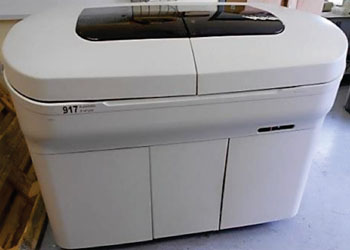Hyaluronic Acid Turbidimetric Assay Compared to Standard Method
By LabMedica International staff writers
Posted on 13 Jan 2016
Circulating hyaluronic acid (HA) in human adults is primarily produced in the peripheral soft connective tissue and transported to the systemic circulation via lymph drainage and the majority of HA is removed from circulation by hepatic elimination. Posted on 13 Jan 2016
HA is essentially non-immunogenic, which has excluded direct immunochemical methods of measurement. To accommodate this, several advanced methods of measurements have been used including enzymatic degradation; hyaluronic-binding protein (HABP) linked enzyme-linked immunosorbent assay (ELISA) and high-performance liquid chromatography.

Image: The Hitachi 917 Automatic Disk-Chemistry Analyzer (Photo courtesy of Roche Diagnostics).
Scientists at the Nordsjaellands Hospital, University of Copenhagen, (Denmark) and their colleagues measured HA concentrations in 39 samples of serum from 39 randomly selected intensive care unit (ICU) patients. The HA was measured by a particle-enhanced turbidimetric immunoassay (PETIA) and enzyme-linked immunosorbent assay (ELISA) in a 40-sample dilution series and the 39 ICU patients.
The HA was measured with the PETIA (Corgenix; Broomfield, CO, USA) in ICU samples on the Hitachi 917 (Roche Diagnostics, GmbH; Mannheim, Germany) and in the dilution series on Modular P (Roche Diagnostics GmbH) analyzers (test assay), and by Corgenix HA ELISA using double determination (reference method).
The scientists found that in the ICU patients, the median HA concentration was 159.0 ng/mL (interquartile range (IQR) 117.5–362.5 ng/mL) with ELISA and 157.5 ng/ml (IQR 92.5–359.6 ng/mL) with PETIA. The mean difference was 12.88 ng/mL which was statistically significant and the 95% limits of agreement were −91.17 to 116.9 ng/mL. In the dilution series, the mean difference was −59.26 ng/mL (95% CI, −74.68 to 43.84 ng/mL, and the 95% limits of agreement were 35.23 to −153.8 ng/mL.
The authors concluded that there was random variation between the PETIA and ELISA test that could affect performance in a clinical context. The new clinical biochemistry assay for HA determination will allow for large studies of the clinical utility of HA. The study was published online on December 14, 2015, in the Journal of Clinical Laboratory Analysis.
Related Links:
Nordsjaellands Hospital
Corgenix
Roche Diagnostics GmbH














